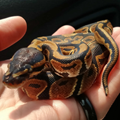» Site Navigation

2 members and 2,976 guests
Most users ever online was 6,337, 01-24-2020 at 04:30 AM.
» Today's Birthdays

» Stats

Members: 75,079
Threads: 248,524
Posts: 2,568,624
Top Poster: JLC (31,651)
|
-
Registered User


What's the deal???
I have a subadult double het albino pied female and a subadult female black pastel albino. They have both been refusing to eat for months now. All my other ball pythons in the same rack have been chowing down. I have been offering their normal F/T rats, then tried live rats: both pups and smalls, and eventually live mice. They refused everything. I got a hold of a couple ASF's and immediately without hesitation they pounced on them. I think it would be too coincidental that they both decided to start eating the same day. It's obviously the introduction of the ASF's that made them eat. Now mind you neither one has ever been fed an ASF, I have owned both since birth. Hopefully this kick starts their feed drive. Does anyone know of any documentation as to why this is so successful? I know this is their native prey, but both of these snakes have been raised in captivity and have never seen an ASF. Could it really be that genetically imprinted in their DNA? Needless to say I just set up a colony of 1.3 ASFs.
-
-
Registered User


Re: What's the deal???
I remember there was an experiment with mice about genetics and scents. The first generation mice were exposed to the scent of cherry blossoms whenever they received a painful shock, so they became conditioned to be afraid of the scent. The thing is that the second and third generation after that, never received the shock, but was still terrified at their first whiff of the cherry blossom scent. Here's a newspaper article about it https://www.washingtonpost.com/natio...fac_story.html
So to me it's possible that something similar happened with the scent of the ASFs except this time encouraging a feeding response.
-
-
Even though they are in a rack there may be a difference in the husbandry of their tubs. Also some snakes seem to be more sensitive to husbandry being off, so first I would check the temperature and humidity of these two tubs. Also are the tubs transparent? If so you may want to cover the exposed side with something. They may just be too small for their current tubs. In this case I would try to add several hides to their tubs or move them to smaller digs. Lastly, I am sure you know this but do not handle them at all until they are feeding consistently again.
Last edited by AntTheDestroyer; 06-14-2016 at 09:43 AM.
-
-
Registered User


Re: What's the deal???
I appreciate the husbandry concerns, but the snake that wasn't eating was in the same rack as ten other BP's that are chowing down. I really wonder if BP's are genetically programmed from years of eating ASF's in their natural environment.
-
-
Registered User


Re: What's the deal???
 Originally Posted by BornToHerp

Does anyone know of any documentation as to why this is so successful? I know this is their native prey, but both of these snakes have been raised in captivity and have never seen an ASF. Could it really be that genetically imprinted in their DNA?
You pretty much nailed it on this part. It's the scent of mice or rats that puts some BPs off since they have a much stronger (and generally different) odor than natural prey. You should see BPs go nuts over gerbils, which don't smell NEARLY as bad as mice. And gerbils are not even from Africa lol.
By the way, you don't necesarilly need to breed Mastomys. i've had plenty BPs that went on a feeding strike for months and only needed one gerbil/ASF and one scented rat to get them going again on normal feeders. Good luck pal
-
 Posting Permissions
Posting Permissions
- You may not post new threads
- You may not post replies
- You may not post attachments
- You may not edit your posts
-
Forum Rules
|








 Reply With Quote
Reply With Quote